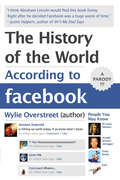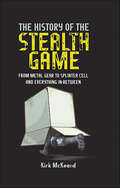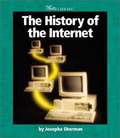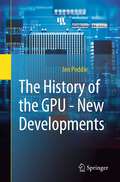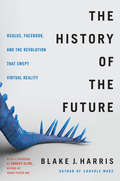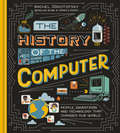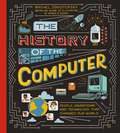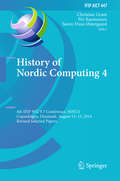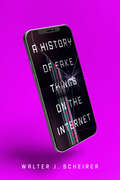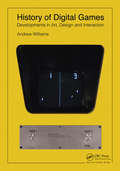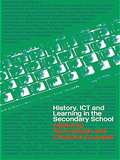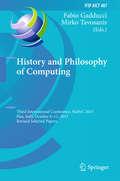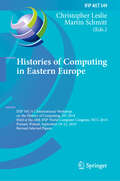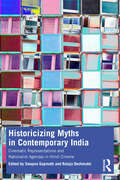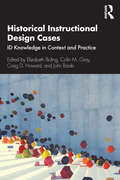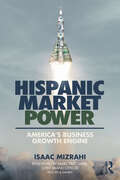- Table View
- List View
The History of the World According to Facebook
by Wylie OverstreetThe Sun is now friends with Earth and 7 other planetsPluto: Not cool.What if Facebook had emerged with the Big Bang, and every historical event took place online? Imagine how we’d we see history if . . .On April 15, 1865, Abraham Lincoln updated his status: "Taking the missus to the theater"God and Stephen Hawking trolled each other in a comment war over the creation of the universe?Alexander the Great "checked into" all the countries he conqueredDonald Trump and Vladimir Putin "Liked" each other's cryptic statusesIrreverent and clever, The History of the World According to Facebook goes back through time, from the beginning of the world to the present, to cover all the major events and eras of human history, such as the Renaissance, the Industrial Revolution, and the Information Age. Filled with hundreds of actual figures from across the centuries and thousands of invented statuses, comments, and actions lampooning Facebook users’ penchant for oversharing, abbreviation, self-importance, and lazy jargon, The History of the World According to Facebook defies all attempts at taking the multi-billion user social media platform SRSLY. It is the funniest parody of history and the dawn of man since, well, the dawn of man.
The History of the Stealth Game: From Metal Gear to Splinter Cell and Everything in Between
by Kirk McKeandFor many, video games are like magic. They hide in the dark and then appear from nowhere, fully formed. Based on over a dozen firsthand interviews that cover genre-defining games and the titles that inspired them — Metal Gear Solid, Thief, Deus Ex, Dishonored, Assassin’s Creed, Hitman, Splinter Cell, Prey, The Last of Us Part II, and more — this book shines a flashlight into the shadowy corners of game development history, uncovering the untold stories behind these formative titles. These insider interviews cover development struggles, internal conflicts, changes in direction, and insight into the reasoning and challenges behind specific mechanics and development decisions. There’s the story of how Thief was developed, in part, by an indie band. It covers Metal Gear Solid’s localization issues and the Americanization of Hideo Kojima’s seminal stealth series, along with a page from the original Metal Gear Solid design document. Elsewhere, one of IO Interactive’s founders explains why Hitman’s Agent 47 is inspired by Coca-Cola, the creator of Assassin’s Creed tells us his vision for the future of the series, and there are plenty of surprises besides. Rather than looking back at the genre as a whole, it traces a line through and connects the dots via personal stories and anecdotes from the people who were there. Foreword written by Arkane’s Harvey Smith.
The History of the Internet
by Josepha ShermanThe beginnings of the Internet can be traced back to the 1960s when APRANET, a military computer network, was developed for the U. S. Department of Defense. This network grew to become what we call the Internet. Learn more about the people who created the Internet and how a small computer network evolved into the international phenomenon it is today.
The History of the GPU - Steps to Invention
by Jon PeddieThis is the first book in a three-part series that traces the development of the GPU. Initially developed for games the GPU can now be found in cars, supercomputers, watches, game consoles and more. GPU concepts go back to the 1970s when computer graphics was developed for computer-aided design of automobiles and airplanes. Early computer graphics systems were adopted by the film industry and simulators for airplanes and high energy physics—exploding nuclear bombs in computers instead of the atmosphere. A GPU has an integrated transform and lighting engine, but these were not available until the end of the 1990s. Heroic and historic companies expanded the development and capabilities of the graphics controller in pursuit of the ultimate device, a fully integrated self-contained GPU. Fifteen companies worked on building the first fully integrated GPU, some succeeded in the console, and Northbridge segments, and Nvidia was the first to offer a fully integrated GPU for the PC. Today the GPU can be found in every platform that involves a computer and a user interface.
The History of the GPU - New Developments
by Jon PeddieThis third book in the three-part series on the History of the GPU covers the second to sixth eras of the GPU, which can be found in anything that has a display or screen. The GPU is now part of supercomputers, PCs, Smartphones and tablets, wearables, game consoles and handhelds, TVs, and every type of vehicle including boats and planes. In the early 2000s the number of GPU suppliers consolidated to three whereas now, the number has expanded to almost 20. In 2022 the GPU market was worth over $250 billion with over 2.2 billion GPUs being sold just in PCs, and more than 10 billion in smartphones. Understanding the power and history of these devices is not only a fascinating tale, but one that will aid your understanding of some of the developments in consumer electronics, computers, new automobiles, and your fitness watch.
The History of the GPU - Eras and Environment
by Jon PeddieThis is the second book in a three-part series that traces the development of the GPU, which is defined as a single chip with an integrated transform and lighting (T&L) capability. This feature previously was found in workstations as a stand-alone chip that only performed geometry functions. Enabled by Moore’s law, the first era of GPUs began in the late 1990s.Silicon Graphics (SGI) introduced T&L first in 1996 with the Nintendo 64 chipset with integrated T&L but didn’t follow through. ArtX developed a chipset with integrated T&L but didn’t bring it to market until November 1999.The need to integrate the transform and lighting functions in the graphics controller was well understood and strongly desired by dozens of companies. Nvidia was the first to produce a PC consumer level single chip with T&L in October 1999. All in all, fifteen companies came close, they had designs and experience, but one thing or another got in their way to prevent them succeeding.All the forces and technology were converging; the GPU was ready to emerge. Several of the companies involved did produce an integrated GPU, but not until early 2000. This is the account of those companies, the GPU and the environment needed to support it. The GPU has become ubiquitous and can be found in every platform that involves a computer and a user interface.
The History of the Future: Oculus, Facebook, and the Revolution That Swept Virtual Reality
by Blake J. HarrisThe dramatic, larger-than-life true story behind the founding of Oculus and its quest for virtual reality, by the bestselling author of Console Wars. Drawing on over a hundred interviews with the key players driving this revolution, The History of the Future weaves together a rich, cinematic narrative that captures the breakthroughs, breakdowns and human drama of trying to change the world. The result is a super accessible and supremely entertaining look at the birth of a game-changing new industry.From iconic books like Neuromancer to blockbuster films like The Matrix, virtual reality has long been hailed as the ultimate technology. But outside of a few research labs and military training facilities, this tantalizing vision of the future was nothing but science fiction. Until 2012, when Oculus founder Palmer Luckey—then just a rebellious teenage dreamer living alone in a camper trailer—invents a device that has the potential to change everything. With the help of a videogame legend, a serial entrepreneur and many other colorful characters, Luckey’s scrappy startup kickstarts a revolution and sets out to bring VR to the masses. As with most underdog stories, things don’t quite go according to plan. But what happens next turns out to be the ultimate entrepreneurial journey: a tale of battles won and lost, lessons learned and neverending twists and turns—including an unlikely multi-billion-dollar acquisition by Facebook’s Mark Zuckerberg, which shakes up the landscape in Silicon Valley and gives Oculus the chance to forever change our reality. Drawing on over a hundred interviews with the key players driving this revolution, The History of the Future weaves together a rich, cinematic narrative that captures the breakthroughs, breakdowns and human drama of trying to change the world. The result is a super accessible and supremely entertaining look at the birth of a game-changing new industry.
The History of the Computer: People, Inventions, and Technology that Changed Our World
by Rachel IgnotofskyA strikingly illustrated overview of the computing machines that have changed our world—from the abacus to the smartphone—and the people who made them, by the New York Times bestselling author and illustrator of Women in Science.Computers are everywhere and have impacted our lives in so many ways. But who created them, and why? How have they transformed the way that we interact with our surroundings and each other?Packed with accessible information, fun facts, and discussion starters, this charming and art-filled book takes you from the ancient world to the modern day, focusing on important inventions, from the earliest known counting systems to the sophisticated algorithms behind AI. The History of the Computer also profiles a diverse range of key players and creators—from An Wang and Margaret Hamilton to Steve Jobs and Sir Tim Berners-Lee—and illuminates their goals, their intentions, and the impact of their inventions on our everyday lives. This entertaining and educational journey will help you understand our most important machines and how we can use them to enhance the way we live. You&’ll never look at your phone the same way again!
The History of the Computer: People, Inventions, And Technology That Changed Our World
by Rachel IgnotofskyExplore the fascinating history of the computer, and the people who made them, in this beautifully illustrated guide for children by bestselling author and illustrator Rachel Ignotofsky.Computers make our lives easier in so many ways - they help us do our work, get directions, check the weather, exercise, shop and understand what's happening around the world. But who created them, and why? How have they transformed the way we interact with our surroundings and each other?Packed with accessible information, fun facts and discussion starters, this charmingly illustrated book takes you from the ancient world to the modern day, focusing on important inventions from the earliest known counting systems (such as the Incan quipu) to the sophisticated algorithms behind AI, space travel and wearable tech. The History of the Computer also profiles a global and diverse range of key players and creators - from An Wang and Margaret Hamilton to Steve Jobs and Tim Berners-Lee - and illuminates their goals, their intentions and the impact of their inventions on our everyday lives.This entertaining and educational journey from the bestselling author of Women in Science will help you understand our most important machines and how we can use them to enhance the way we live. You'll never look at your phone the same way again!
History of Nordic Computing 4
by Christian Gram Per Rasmussen Søren Duus ØstergaardThis book constitutes the refereed post-proceedings of the 4th IFIP WG 9. 7 Conference on the History of Nordic Computing, HiNC 4, held in Copenhagen, Denmark, in August 2014. The 37 revised full papers were carefully reviewed and selected for inclusion in this volume. The papers focus on innovative ICT milestones that transformed the nordic societies and on the new ideas, systems and solutions that helped creating the welfare societies of today, in particular solutions and systems for public services, e. g. , tax, social benefits, health care and education; solutions and systems for the infrastructure of the society, e. g. , banking, insurance, telephones, transport and energy supply; and technologies and IT policies behind the major IT milestones, e. g. , user centric innovation, programming techniques and IT ethics. They are organized in topical sections on IT policy, infrastructure, public services, private services, telesystems, health care, IT in banking, transport and IT technology.
The History of Information Security: A Comprehensive Handbook
by Karl Maria Michael De Leeuw Jan BergstraInformation Security is usually achieved through a mix of technical, organizational and legal measures. These may include the application of cryptography, the hierarchical modeling of organizations in order to assure confidentiality, or the distribution of accountability and responsibility by law, among interested parties. <p><p> The history of Information Security reaches back to ancient times and starts with the emergence of bureaucracy in administration and warfare. Some aspects, such as the interception of encrypted messages during World War II, have attracted huge attention, whereas other aspects have remained largely uncovered. <p><p>There has never been any effort to write a comprehensive history. This is most unfortunate, because Information Security should be perceived as a set of communicating vessels, where technical innovations can make existing legal or organisational frame-works obsolete and a breakdown of political authority may cause an exclusive reliance on technical means. <p><p> This book is intended as a first field-survey. It consists of twenty-eight contributions, written by experts in such diverse fields as computer science, law, or history and political science, dealing with episodes, organisations and technical developments that may considered to be exemplary or have played a key role in the development of this field. <p><p> These include: the emergence of cryptology as a discipline during the Renaissance, the Black Chambers in 18th century Europe, the breaking of German military codes during World War II, the histories of the NSA and its Soviet counterparts and contemporary cryptology. <p><p>Other subjects are: computer security standards, viruses and worms on the Internet, computer transparency and free software, computer crime, export regulations for encryption software and the privacy debate. <p><p> - Interdisciplinary coverage of the history Information Security<p> - Written by top experts in law, history, computer and information science<p> - First comprehensive work in Information Security
A History of Fake Things on the Internet
by Walter ScheirerA Next Big Idea Club "Must Read" for December 2023 As all aspects of our social and informational lives increasingly migrate online, the line between what is "real" and what is digitally fabricated grows ever thinner—and that fake content has undeniable real-world consequences. A History of Fake Things on the Internet takes the long view of how advances in technology brought us to the point where faked texts, images, and video content are nearly indistinguishable from what is authentic or true. Computer scientist Walter J. Scheirer takes a deep dive into the origins of fake news, conspiracy theories, reports of the paranormal, and other deviations from reality that have become part of mainstream culture, from image manipulation in the nineteenth-century darkroom to the literary stylings of large language models like ChatGPT. Scheirer investigates the origins of Internet fakes, from early hoaxes that traversed the globe via Bulletin Board Systems (BBSs), USENET, and a new messaging technology called email, to today's hyperrealistic, AI-generated Deepfakes. An expert in machine learning and recognition, Scheirer breaks down the technical advances that made new developments in digital deception possible, and shares behind-the-screens details of early Internet-era pranks that have become touchstones of hacker lore. His story introduces us to the visionaries and mischief-makers who first deployed digital fakery and continue to influence how digital manipulation works—and doesn't—today: computer hackers, digital artists, media forensics specialists, and AI researchers. Ultimately, Scheirer argues that problems associated with fake content are not intrinsic properties of the content itself, but rather stem from human behavior, demonstrating our capacity for both creativity and destruction.
History of Digital Games: Developments in Art, Design and Interaction
by Andrew WilliamsThe growth of videogame design programs in higher education and explosion of amateur game development has created a need for a deeper understanding of game history that addresses not only "when," but "how" and "why." Andrew Williams takes the first step in creating a comprehensive survey on the history of digital games as commercial products and artistic forms in a textbook appropriate for university instruction. History of Digital Games adopts a unique approach and scope that traces the interrelated concepts of game design, art and design of input devices from the beginnings of coin-operated amusement in the late 1800s to the independent games of unconventional creators in the present. Rooted in the concept of videogames as designed objects, Williams investigates the sources that inspired specific game developers as well as establishing the historical, cultural, economic and technological contexts that helped shape larger design trends
A History of Data Visualization and Graphic Communication
by Michael Friendly Howard WainerA comprehensive history of data visualization—its origins, rise, and effects on the ways we think about and solve problems. With complex information everywhere, graphics have become indispensable to our daily lives. Navigation apps show real-time, interactive traffic data. A color-coded map of exit polls details election balloting down to the county level. Charts communicate stock market trends, government spending, and the dangers of epidemics. A History of Data Visualization and Graphic Communication tells the story of how graphics left the exclusive confines of scientific research and became ubiquitous. As data visualization spread, it changed the way we think. Michael Friendly and Howard Wainer take us back to the beginnings of graphic communication in the mid-seventeenth century, when the Dutch cartographer Michael Florent van Langren created the first chart of statistical data, which showed estimates of the distance from Rome to Toledo. By 1786 William Playfair had invented the line graph and bar chart to explain trade imports and exports. In the nineteenth century, the “golden age” of data display, graphics found new uses in tracking disease outbreaks and understanding social issues. Friendly and Wainer make the case that the explosion in graphical communication both reinforced and was advanced by a cognitive revolution: visual thinking. Across disciplines, people realized that information could be conveyed more effectively by visual displays than by words or tables of numbers. Through stories and illustrations, A History of Data Visualization and Graphic Communication details the 400-year evolution of an intellectual framework that has become essential to both science and society at large.
A History of Cyber Security Attacks: 1980 to Present
by Bruce MiddletonStories of cyberattacks dominate the headlines. Whether it is theft of massive amounts of personally identifiable information or the latest intrusion of foreign governments in U.S. government and industrial sites, cyberattacks are now important. For professionals and the public, knowing how the attacks are launched and succeed is vital to ensuring cyber security. The book provides a concise summary in a historical context of the major global cyber security attacks since 1980. Each attack covered contains an overview of the incident in layman terms, followed by a technical details section, and culminating in a lessons learned and recommendations section.
History of Cryptography and Cryptanalysis: Codes, Ciphers, and Their Algorithms (History of Computing)
by John F. DooleyThis accessible textbook presents a fascinating review of cryptography and cryptanalysis across history. The text relates the earliest use of the monoalphabetic cipher in the ancient world, the development of the “unbreakable” Vigenère cipher, and an account of how cryptology entered the arsenal of military intelligence during the American Revolutionary War. Moving on to the American Civil War, the book explains how the Union solved the Vigenère ciphers used by the Confederates, before investigating the development of cipher machines throughout World War I and II. This is then followed by an exploration of cryptology in the computer age, from public-key cryptography and web security, to criminal cyber-attacks and cyber-warfare. Looking to the future, the role of cryptography in the Internet of Things is also discussed, along with the potential impact of quantum computing.Topics and features: presents a history of cryptology from ancient Rome to the present day, with a focus on cryptology in the 20th and 21st centuries; reviews the different types of cryptographic algorithms used to create secret messages, and the various methods for breaking such secret messages; provides engaging examples throughout the book illustrating the use of cryptographic algorithms in different historical periods; describes the notable contributions to cryptology of Herbert Yardley, William and Elizebeth Smith Friedman, Lester Hill, Agnes Meyer Driscoll, and Claude Shannon; concludes with a review of tantalizing unsolved mysteries in cryptology, such as the Voynich Manuscript, the Beale Ciphers, and the Kryptos sculpture.This engaging work is ideal as both a primary text for courses on the history of cryptology, and as a supplementary text for advanced undergraduate courses on computer security. No prior background in mathematics is assumed, beyond what would be encountered in an introductory course on discrete mathematics.
A History of Communications
by Marshall T. PoeA History of Communications advances a new theory of media that explains the origins and impact of different forms of communication – speech, writing, print, electronic devices and the Internet – on human history in the long term. New media are 'pulled' into widespread use by broad historical trends and these media, once in widespread use, 'push' social institutions and beliefs in predictable directions. This view allows us to see for the first time what is truly new about the Internet, what is not, and where it is taking us.
History, ICT and Learning in the Secondary School
by Terry Haydn Christine CounsellThis book explores the current use and potential of ICT in the secondary history curriculum, and offers sound theory and practical advice to help secondary history teachers use ICT effectively. Key areas covered include: getting started in ICT and history short, medium and long-term planning using ICT to develop historical understanding and skills data handling in the history classroom ICT and maps integrating virtual resources with the real world of teaching and learning. With contributions from leading academics and practitioners in history education, this book will be important reading for all secondary history teachers and trainee teachers, but will be of interest to upper primary school teachers too.
History and Philosophy of Computing
by Fabio Gadducci Mirko TavosanisThis volume constitutes the refereed post-conference proceedings of the Third International Conference on the History and Philosophy of Computing, held in Pisa, Italy in October 2015. The 18 full papers included in this volume were carefully reviewed and selected from the 30 papers presented at the conference. They cover topics ranging from the world history of computing to the role of computing in the humanities and the arts.
Histories of Computing in Eastern Europe: IFIP WG 9.7 International Workshop on the History of Computing, HC 2018, Held at the 24th IFIP World Computer Congress, WCC 2018, Poznań, Poland, September 19–21, 2018, Revised Selected Papers (IFIP Advances in Information and Communication Technology #549)
by Christopher Leslie Martin SchmittThis book consitutes the refereed post-conference proceedings of the IFIP WG 9.7 International Workshop on the History of Computing, HC 2018, Held at the 24th IFIP World Computer Congress, WCC 2018, in Poznań, Poland, in September 2018.The 16 revised full papers were carefully reviewed and selected from 20 submissions. They reflect academic approaches to history along with the expertise of museum and other public history professionals as well as the experience of computingand information science practitioners. The papers are organized in the following sections: Eastern Europe, Poland, Soviet Union, CoCom and Comecon; analog computing, and public history.
Historicizing Myths in Contemporary India: Cinematic Representations and Nationalist Agendas in Hindi Cinema
by Swapna Gopinath Rutuja DeshmukhThis book examines cinematic practices in Bollywood as narratives that assist in shaping the imagination of the age, especially in contemporary India. It examines historical films released in India since the new millennium and analyses cinema as a reflection of the changing socio-political and economic conditions at any given period. The chapters in Historicizing Myths in Contemporary India: Cinematic Representations and Nationalist Agendas in Hindi Cinemas also illuminate different perspectives on how cinematic historical representations follow political patterns and market compulsions, giving precedence to a certain past over the other, creating a narrative suited for the dominant narrative of the present. From Mughal-e-Azam to Padmaavat, and Bajirao Mastani to Raazi, the chapters show how creating history out of myths validate hegemonic identities in a rapidly evolving Indian society. The volume will be of interest to scholars of film and media studies, literature and culture studies, and South Asian studies.
Historical Studies in Computing, Information, and Society: Insights from the Flatiron Lectures (History of Computing)
by William AsprayThis is a volume of chapters on the historical study of information, computing, and society written by seven of the most senior, distinguished members of the History of Computing field. These are edited, expanded versions of papers presented in a distinguished lecture series in 2018 at the University of Colorado Boulder – in the shadow of the Flatirons, the front range of the Rocky Mountains. Topics range widely across the history of computing. They include the digitalization of computer and communication technologies, gender history of computing, the history of data science, incentives for innovation in the computing field, labor history of computing, and the process of standardization. Authors were given wide latitude to write on a topic of their own choice, so long as the result is an exemplary article that represents the highest level of scholarship in the field, producing articles that scholars in the field will still look to read twenty years from now. The intention is to publish articles of general interest, well situated in the research literature, well grounded in source material, and well-polished pieces of writing. The volume is primarily of interest to historians of computing, but individual articles will be of interest to scholars in media studies, communication, computer science, cognitive science, general and technology history, and business.
Historical Instructional Design Cases: ID Knowledge in Context and Practice
by Elizabeth Boling Colin M. Gray Craig D. Howard John BaakiHistorical Instructional Design Cases presents a collection of design cases which are historical precedents for the field with utility for practicing designers and implications for contemporary design and delivery. Featuring concrete and detailed views of instructional design materials, programs, and environments, this book’s unique curatorial approach situates these cases in the field’s broader timeline while facilitating readings from a variety of perspectives and stages of design work. Students, faculty, and researchers will be prepared to build their lexicon of observed designs, understand the real-world outcomes of theory application, and develop cases that are fully accessible to future generations and contexts.
Hispanic Market Power: America’s Business Growth Engine
by Isaac MizrahiThe US Hispanic segment represents the most prominent demographic growth in the country, and a huge and untapped business opportunity for companies willing to move away from preconceived notions and market effectively to Hispanic customers. This book shows you how. Now more than ever, corporations operating in the US should see the Hispanic population at the core of their existing and future strategies, but many leaders believe Hispanic marketing is the same marketing you run for Anglos but translated into Spanish, or that all Hispanics are undocumented immigrants with no purchasing power, or that using Mariachis in their communications is the way to connect with this diverse segment. It’s time for a modern approach, and in this book, Isaac Mizrahi, one of the country’s leading voices in multicultural marketing, uses his unique experience as a corporate executive, agency CEO, and industry leader to help businesses grow by leveraging the booming Hispanic consumer segment to drive sales. Filled with straightforward talk, illustrative case studies, and pragmatic suggestions and recommendations, this book counterbalances academic books on the topic with little connection to day-to-day reality and other books with a more political standpoint. This is a business book created by a marketer for other marketers and business leaders looking to succeed in the US.
Hiring Geeks That Fit
by Johanna Rothman"Do you want to hire great people? Not sure how? Read this book.Knowledge workers -- your geeks -- are different from skill-based staff. So, you should hire them differently. You need to analyze your situation, determine the problems you have, understand your culture, and then you can hire the right kinds of people.Cultural fit is critical, because we rarely fire people based on technical skill. But we frequently fire them because of that elusive fit. And, that's an expensive proposition.Hiring great geeks forces you to recognize and match culture, non-technical qualities, preferences and skills, and finally, technical skills. These people will adapt their knowledge to your specific situation, the context. They are the sum of both what they know and how they apply that knowledge to the product.As a result, one developer, tester, or technical manager is not interchangeable with another. This makes hiring technical people one of the most critical and difficult processes a technical manager or team can undertake.Hiring Geeks That Fit takes the guesswork out of hiring and reduces the risk of costly hiring mistakes. You'll learn how to:Develop a hiring strategy so you know how to solve your problemAnalyze the job, so the job description and ad falls out of the analysisI Source candidates, using a variety of approaches including LinkedIn and TwitterDevelop effective ads for different mediumsReview resumes quickly to determine Yes, No, or Maybe candidatesDevelop behavior-description questions and auditionsCreate phone screens that help you know who to bring in for an in-person interviewMake the most of an in-person interviewCheck referencesExtend an offer that will attract a win-win acceptance or tender a gentle-but-decisive rejectionCreate a great first day experience for new hiresLearn how to create a buddy system to decrease the cost of a new hireWhat to do if you can't find someoneYou, your team, and your organization will live with the long-term consequences of your hiring decision. Investing the time for you and your team in how to hire and interview will pay off fast.This book was written and produced entirely by the author. We are proud to be distributing it."
